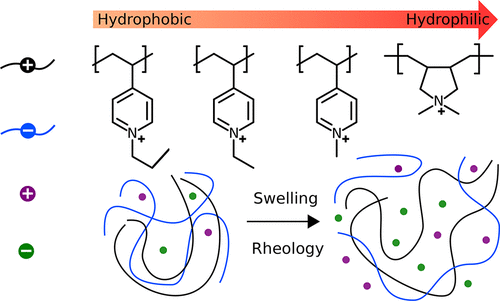当前位置:
X-MOL 学术
›
Macromolecules
›
论文详情
Our official English website, www.x-mol.net, welcomes your
feedback! (Note: you will need to create a separate account there.)
Influence of Hydrophobicity on Polyelectrolyte Complexation
Macromolecules ( IF 5.1 ) Pub Date : 2017-11-16 00:00:00 , DOI: 10.1021/acs.macromol.7b02031 Kazi Sadman 1 , Qifeng Wang 1 , Yaoyao Chen 1 , Bavand Keshavarz 2 , Zhang Jiang 3 , Kenneth R. Shull 1
Macromolecules ( IF 5.1 ) Pub Date : 2017-11-16 00:00:00 , DOI: 10.1021/acs.macromol.7b02031 Kazi Sadman 1 , Qifeng Wang 1 , Yaoyao Chen 1 , Bavand Keshavarz 2 , Zhang Jiang 3 , Kenneth R. Shull 1
Affiliation

|
Polyelectrolyte complexes are a fascinating class of soft materials that can span the full spectrum of mechanical properties from low-viscosity fluids to glassy solids. This spectrum can be accessed by modulating the extent of electrostatic association in these complexes. However, to realize the full potential of polyelectrolyte complexes as functional materials, their molecular level details need to be clearly correlated with their mechanical response. The present work demonstrates that by making simple amendments to the chain architecture, it is possible to affect the salt responsiveness of polyelectrolyte complexes in a systematic manner. This is achieved by quaternizing poly(4-vinylpyridine) (QVP) with methyl, ethyl, and propyl substituents—thereby increasing the hydrophobicity with increasing side chain length—and complexing them with a common anionic polyelectrolyte, poly(styrenesulfonate). The mechanical behavior of these complexes is compared to the more hydrophilic system of poly(styrenesulfonate) and poly(diallyldimethylammonium) by quantifying the swelling behavior in response to salt stimuli. More hydrophobic complexes are found to be more resistant to doping by salt, yet the mechanical properties of the complex remain contingent on the overall swelling ratio of the complex itself, following near universal swelling–modulus master curves that are quantified in this work. The rheological behaviors of QVP complex coacervates are found to be approximately the same, only requiring higher salt concentrations to overcome strong hydrophobic interactions, demonstrating that hydrophobicity can be used as an important parameter for tuning the stability of polyelectrolyte complexes in general, while still preserving the ability to be processed “saloplastically”.
中文翻译:

疏水性对聚电解质络合的影响
聚电解质复合物是一类引人入胜的软材料,可以涵盖从低粘度流体到玻璃态固体的全部机械性能。可以通过调节这些络合物中的静电缔合程度来获得该光谱。然而,为了充分发挥聚电解质复合物作为功能材料的潜力,需要将其分子水平的细节与它们的机械响应明确联系起来。本工作表明,通过对链结构进行简单的修改,有可能以系统的方式影响聚电解质配合物的盐响应性。这是通过将聚(4-乙烯基吡啶)(QVP)与甲基,乙基,和丙基取代基(从而随侧链长度的增加而增加疏水性)并使它们与常见的阴离子聚电解质聚(苯乙烯磺酸盐)络合。通过定量响应盐刺激的溶胀行为,将这些配合物的机械性能与亲水性更高的聚苯乙烯磺酸盐和聚二烯丙基二甲基铵体系进行了比较。人们发现,更多的疏水复合物更耐盐掺杂,但复合物的机械性能仍然取决于复合物自身的总溶胀率,其遵循的通用溶胀模量主曲线在这项工作中得到了量化。发现QVP复合凝聚层的流变行为大致相同,只需要较高的盐浓度即可克服强烈的疏水性相互作用,
更新日期:2017-11-16
中文翻译:

疏水性对聚电解质络合的影响
聚电解质复合物是一类引人入胜的软材料,可以涵盖从低粘度流体到玻璃态固体的全部机械性能。可以通过调节这些络合物中的静电缔合程度来获得该光谱。然而,为了充分发挥聚电解质复合物作为功能材料的潜力,需要将其分子水平的细节与它们的机械响应明确联系起来。本工作表明,通过对链结构进行简单的修改,有可能以系统的方式影响聚电解质配合物的盐响应性。这是通过将聚(4-乙烯基吡啶)(QVP)与甲基,乙基,和丙基取代基(从而随侧链长度的增加而增加疏水性)并使它们与常见的阴离子聚电解质聚(苯乙烯磺酸盐)络合。通过定量响应盐刺激的溶胀行为,将这些配合物的机械性能与亲水性更高的聚苯乙烯磺酸盐和聚二烯丙基二甲基铵体系进行了比较。人们发现,更多的疏水复合物更耐盐掺杂,但复合物的机械性能仍然取决于复合物自身的总溶胀率,其遵循的通用溶胀模量主曲线在这项工作中得到了量化。发现QVP复合凝聚层的流变行为大致相同,只需要较高的盐浓度即可克服强烈的疏水性相互作用,











































 京公网安备 11010802027423号
京公网安备 11010802027423号